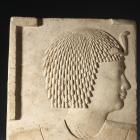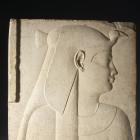Models for the sculptor, limestone, early Ptolemaic period (4th – 3rd century BC), unknown origin (n. inv. E 0.9.40015-0.9.40016)
Skilled egyptian sculptors used small and easily transportable model slabs, to carve or teach relief sculptures. These models are known to have already been in use during the New Kingdom (16th - 12th century BC), but they became more widespread in the Late and Ptolemaic period (7th century BC).
The museum possesses two such refined models in limestone of unknown origin. One portraying the profile of a sovereign wearing a blue crown and the uraeus: the cobra, used as a symbol of royalty. The other, carved on both sides, depicts the profile of a young sovereign wearing an elaborate wig, with the uraeus on his forehead and a barely outlined large necklace. The reverse side is the bust of a female wearing a vulture shaped headdress, a royal as well as divine attribute.
The heads of the three figures on the slabs are depicted in profile, according to the canons of the early period, with the eye and front shoulder facing the viewer, however the style of the carving: the rounded face and large creased lips betray that the model is of a later period, that of the early Ptolemaic Era.









